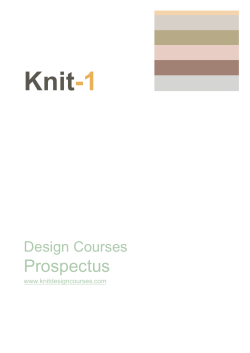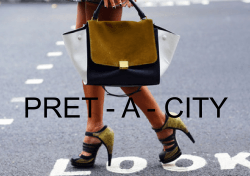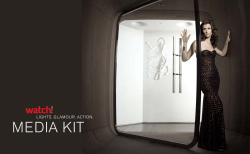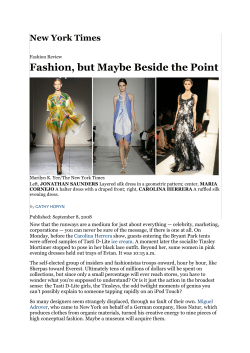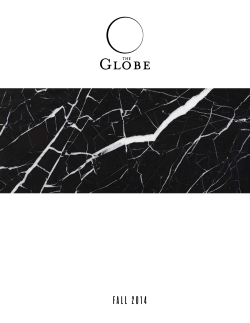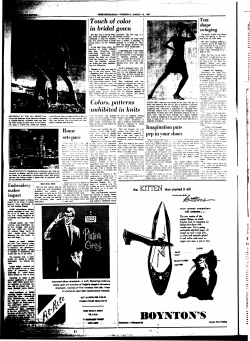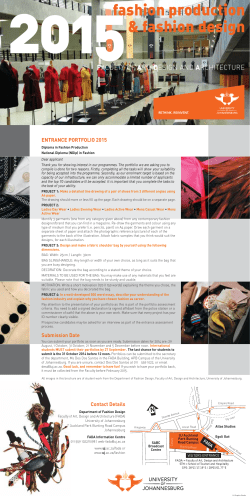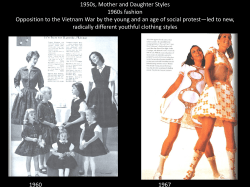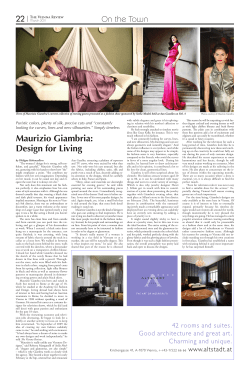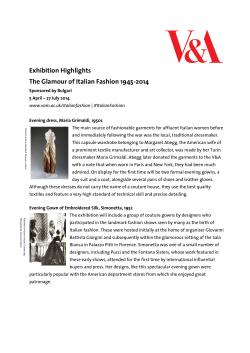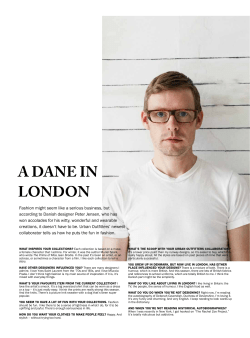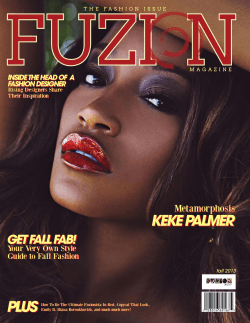
Course Volume in Course valid Course group
COURSE DESCRIPTION (Group C) Course code Course group Volume in ECTS credits Course valid from 16 2014 MAD3001 Course type (compulsory or optional) Course level (study cycle) Semester the course is delivered Study form (face-to-face or distant) Course title in Lithuanian Course valid to Reg. No. Compulsory BA III year, I semester Face-to-face Mados dizainas V Course title in English Fashion Design V Short course annotation in Lithuanian Pasiruošdami atlikti baigiamąjį darbą studentai turės atlikti užduotis šiose srityse: • Apsilankyti vienoje iš mados sostinių ir atlikti tyrimus remiantis šiuolaikine mados paroda, muziejumi ar gatvės stiliumi, • Tęsti kūrybinį darbą kituose savarankiškai sukurtuose projektuose. • Išanalizuoti siluetą ir pasirinkti siuvamam gaminiui tinkamus audinius. • Išanalizuoti asmeninį požiūrį į pasirinktos srities madą. • Dalyvauti nacionaliniame/tarptautiniame mados dizaino konkurse, palyginti savo ir kitų bendraamžių darbus. Short course annotation in English (up to 500 characters) In order to work towards their final collection the students will need to carry out work in the following areas: • A visit to a major fashion capital, a major trends exhibition, museum or street - style primary researching. • To continue design work on a series of other personally instigated briefs. • To investigate silhouette and fabric sourcing. • To investigate a personal approach to a selected area of fashion. • To enter national/international design competition in order to view the individuals work alongside other contemporaries. Prerequisites for entering the course Fashion design I, Fashion design II, Illustration and Presentation Techniques, Basic Tailoring and Cutting, Fashion Design III, Fashion Design IV, Historical Contextual Studies, Contemporary Contextual Studies Course aim This module aims to allow students to fully prepare for progressing their final collection at the end of their programme of study. The students will have opportunity to see the work against their peers at national level, experience to gain knowledge of forthcoming fabric and fashion trends via trade exhibitions and start the preparatory grounding for their collection. Links between study programme outcomes, course outcomes, study methods, and criteria of learning achievement evaluation Study programme outcomes Course outcomes Study (teaching and learning) methods Criteria of learning achievement evaluation 1. Demonstrate imagination, innovation and creative thinking to a range of practical fashion design problems. 2. Demonstrate knowledge and understanding of art history and theory as well as cultural phenomena in relation to fashion and textile industry, identifying the relationship of design history to society and culture. 3. Identify and assess relevant sources and methods employed in fashion design and apply them to their own creative practice in the aforementioned context. 4. Demonstrate an ability to technologically and methodically integrate the use of all fashion design practices: product (clothing) design, implementation and Demonstrate imagination, innovation and creative thinking to a range of abstract problems through live projects set by industry. Lectures and briefings, studio sessions, group and individual tutorials, library Work, research project work, creative project work Student builds a professional portfolio that reflects individual creative style whilst demonstrating to the potential employer the individual skills and knowledge the student has suitable for the workplace. Build a professional portfolio that reflects individual creative style whilst demonstrating to the potential employer the individual skills and knowledge the student has suitable for the workplace. Evaluate in-depth knowledge of current fashion trends and input own work into that context. Evidence a thorough range of research strategies and methodologies when identifying customer profile and market levels. Evidence fully developed design ideas via personally identified projects while continuing to develop a personal style. Evidence fully developed design ideas via personally identified projects while continuing to develop a personal style. Student demonstrates imagination, innovation and creative thinking to a range of abstract problems through live projects set by industry. Student evaluates in-depth knowledge of current fashion trends and input own work into that context. Lectures and briefings, studio sessions, group and individual tutorials, library Work, research project work, creative project work Student evidences a thorough range of research strategies and methodologies when identifying customer profile and market levels. Student evidences fully developed design ideas via personally identified projects while continuing to develop a personal style. Lectures and briefings, studio sessions, group and individual tutorials, library Work, research project work, creative project work Student evidences fully developed design ideas via personally identified projects while continuing to develop a personal style. delivery. 5. Evidence an in-depth knowledge and understanding of complex body forms and garment proportions, shapes, silhouettes, fabrics and colours, and the ability to apply them to their own practice. Evidence numerical skills in relation to advanced level of pattern cutting and tailoring. Lectures and briefings, studio sessions, group and individual tutorials, library Work, research project work, creative project work Student evidences numerical skills in relation to advanced level of pattern cutting and tailoring. 6. Develop and implement fashion design, textile and apparel projects in practice, contribute independently and confidently to team projects. Evidence original, innovative and imaginative responses within the constraints of fashion competitions . Lectures and briefings, studio sessions, group and individual tutorials, library Work, research project work, creative project work Student evidences original, innovative and imaginative responses within the constraints of fashion competitions. 7. Demonstrate an ability to independently plan and manage time in achieving set goals and follow a personal work ethic, recognize an in-depth knowledge of market levels and customer profile, demonstrate an ability to adapt to constant and unpredictable changes brought on by advances in technological knowledge in the field of a professional fashion designer. Demonstrate an ability to manage time and output to a standard required in professional practice. Lectures and briefings, studio sessions, group and individual tutorials, library Work, research project work, creative project work Student demonstrates an ability to manage time and output to a standard required in professional practice. Link between course outcomes and content Course outcomes Evidence a thorough range of research strategies and 1. methodologies when identifying customer profile and market levels. Evaluate in-depth knowledge of current fashion trends and 2. input own work into that context. Evidence original, innovative and imaginative responses within 3. the constraints of fashion competitions. 4. 5. Evidence fully developed design ideas via personally identified projects while continuing to develop a personal style. Evidence numerical skills in relation to advanced level of Content (topics) Design work on a series of personally instigated briefs Silhouette and fabric sourcing investigation Practice based on entering national/international design competition Individual creative style development Portfolio as a mean for self- 6. pattern cutting and tailoring. management. Demonstrate an ability to manage time and output to a standard required in professional practice. Time management Methods of learning achievement assessment Lecture based delivery, supervised studio workshops, group work and critiques, self-directed study, group and individual presentations. Distribution of workload for students (contact and independent work hours) SCHEDULED LEARNING AND TEACHING ACTIVITY: 160 hours lectures and briefings, studio sessions, group and individual tutorials GUIDED INDEPENDENT STUDY: library work, research 268 hours project work, creative project work Total: 428 hours Structure of cumulative score and value of its constituent parts Number of Assessments Form of Assessment % weighting 2 Course work 100% (2 x Portfolio Submission 50%) Size of Assessment/Duration/ Wordcount Category of assessment Learning Outcomes being assessed Coursework 1-6 Recommended reference materials No. Publication year Authors of publication and title Publishing house Number of copies in University Self-study Other library rooms libraries Basic materials 1. 2002 Barnard, M. Fashion as Communication. 2nd ed. 2. 2009 Armstrong, H J. Patternmaking for Fashion Design. 5th ed. 3. 4. 2011 2005 5. 2010 6. 2000 7. 2009 Baugh, G. The Fashion Designer's Textile Directory: The Creative Use of Fabrics in Design. Black, S. Knitwear in Fashion. Cook, B. How to Write a Press Release: 84 Easy Tips to Get Free Publicity for Your Business or Website. Cotton, C. Imperfect Beauty: The Making of Contemporary Fashion Photographs. Innes, J. The Interview Book: London: Routledge. London: Pearson Education. London: Thames & Hudson. London: Thames & Hudson. 1 1 1 1 London: Createspace 1 London: V & A Publishing. 1 London: 1 Your Definitive Guide to the Perfect Interview Technique. 8. 2008 Jones, T. Fashion Now: v. 2 (Big Art). Prentice Hall Cologne: Taschen GmbH. 1 Supplementary materials 9. 2002 10. 2006 11. 2003 Kyoto Costume Inst. Fashion A History From The 18th To The 20th Century (Midi Series). Malcolm, T. Vogue Knitting Stitchionary: The Ultimate Stitch Dictionary: Knit and Purl v. 1. McDowell, C. Fashion Today. 2nd ed Cologne: Taschen GmbH. 1 London: Sixth and Spring Books 1 London: Phaidon Press Sanders, M & Poynter, P. London: BoothDazed/Confused. Clibborn editions. Vogue Knit Editors. Vogue Knitting London: Sixth and Stitchionary Volume Four: 13. 2008 Spring Books. Crochet: The Ultimate Stitch Dictionary: Crochet v. 4. Wiseman, N M. Knitting London: 14. 2003 with Wire (Knitting Interweave Press Technique Series). Inc. Course programme designed by Agnė Kuzmickaitė, Agnė Biskytė, Rita Kaupelienė 12. 2002 1 1 1 1
© Copyright 2026
